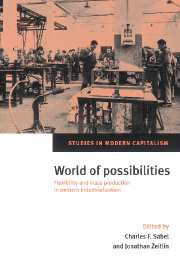Book contents
- Frontmatter
- Contents
- List of contributors
- Acknowledgments
- Stories, strategies, structures: rethinking historical alternatives to mass production
- Part I The modernity of tradition
- Part II The battle of the systems
- 5 Between flexibility and mass production: strategic ambiguity and selective adaptation in the British engineering industry, 1830–1914
- 6 The lost paradigm: an Italian metalworking empire between competing models of production, 1900–1920
- 7 “Have a heart for the manufacturers!”: production, distribution and the decline of American textile manufacturing
- 8 The small-holder economy in Denmark: the exception as variation
- Part III The resurgence of flexible production
- Index
5 - Between flexibility and mass production: strategic ambiguity and selective adaptation in the British engineering industry, 1830–1914
Published online by Cambridge University Press: 12 December 2009
- Frontmatter
- Contents
- List of contributors
- Acknowledgments
- Stories, strategies, structures: rethinking historical alternatives to mass production
- Part I The modernity of tradition
- Part II The battle of the systems
- 5 Between flexibility and mass production: strategic ambiguity and selective adaptation in the British engineering industry, 1830–1914
- 6 The lost paradigm: an Italian metalworking empire between competing models of production, 1900–1920
- 7 “Have a heart for the manufacturers!”: production, distribution and the decline of American textile manufacturing
- 8 The small-holder economy in Denmark: the exception as variation
- Part III The resurgence of flexible production
- Index
Summary
Few cases are more difficult to categorize as either flexible or mass production than that of the British engineering industry between 1830 and 1914. Through most of the nineteenth century, Britain's continental competitors saw her dominance of world trade in machinery– like that in cotton textiles – as the result of mass production in the contemporary sense of the term: the use of powered machinery and the subdivision of labor to manufacture significant quantities of relatively standardized products at low prices. So great was Britain's advantage in textile machinery, for example, that emergent manufacturers in Germany were forced from the outset to concentrate on “specialized products which complemented British spinning equipment or looms or produced yarn or cloth that could not be made with standard machines.” Yet in the 1850s, when British engineers inspected American techniques for manufacturing products such as locks and small arms, the latter's use of jigs, fixtures, gauges and special machines to produce interchangeable parts seemed distinctive enough from British methods to be termed “the American system of manufactures.” By the end of the nineteenth century, when American firms manufacturing large volumes of standardized equipment had begun to penetrate world markets, the contrast with their British counterparts' use of craft methods to manufacture customized products in small batches had become a commonplace of engineering comment on both sides of the Atlantic. These conflicting perceptions of British engineering reflected real ambiguities in domestic practice, whose significance would only become apparent as new competitive pressures from both mass and flexible producers forced the industry to redefine its identity through a process of strategic debate and selective adaptation.
- Type
- Chapter
- Information
- World of PossibilitiesFlexibility and Mass Production in Western Industrialization, pp. 241 - 272Publisher: Cambridge University PressPrint publication year: 1997
- 1
- Cited by



